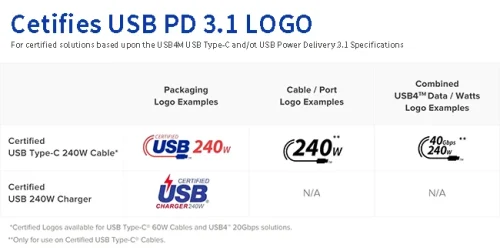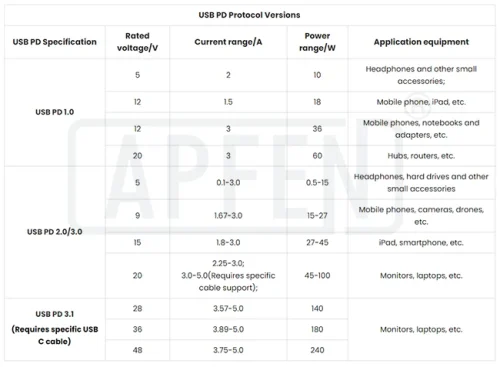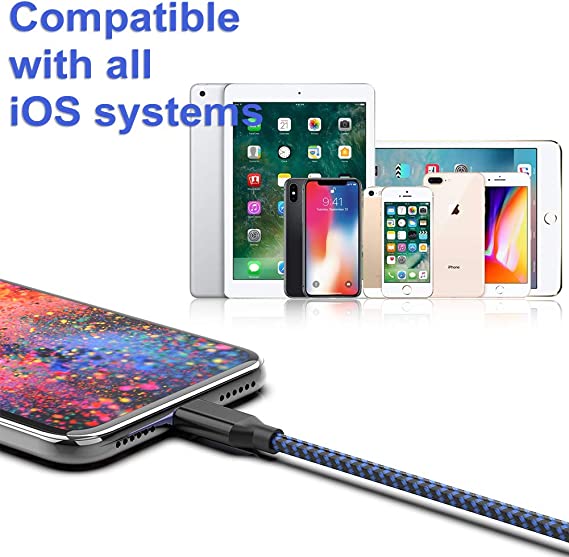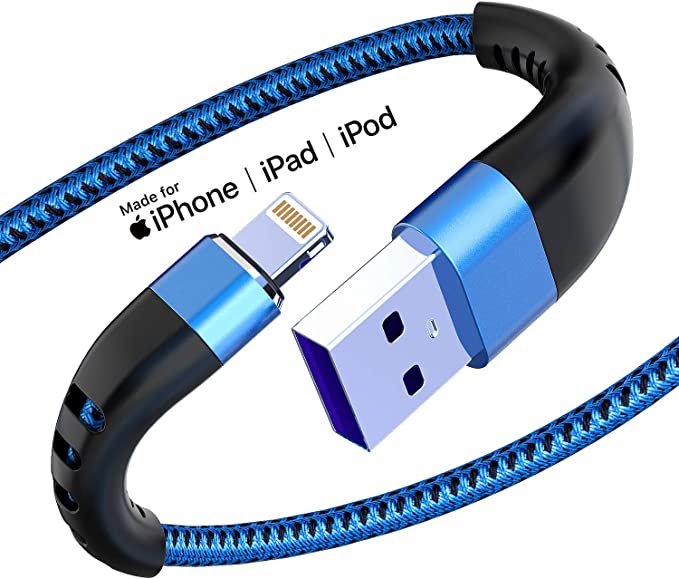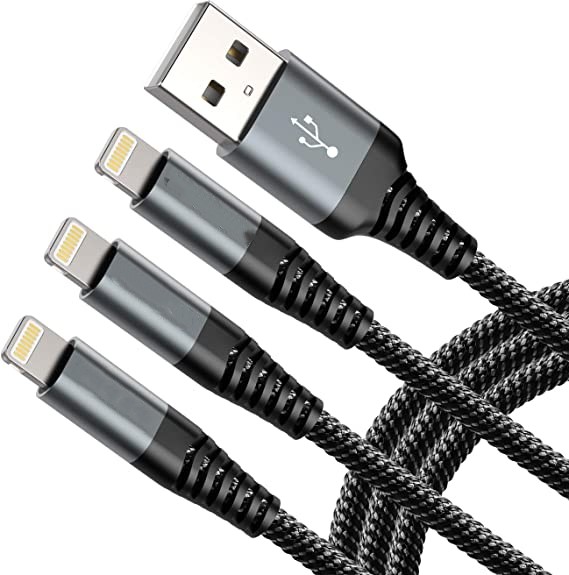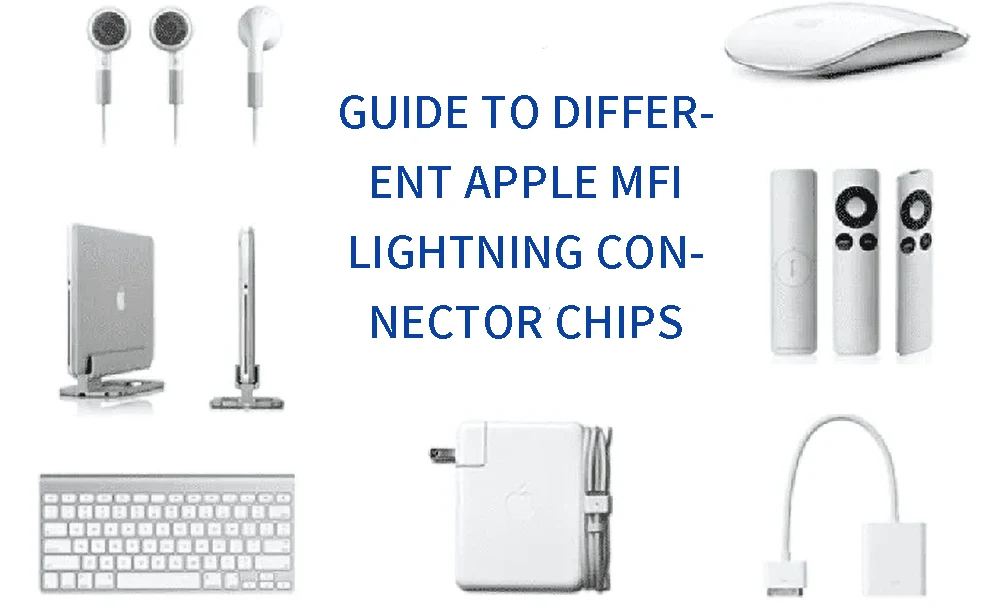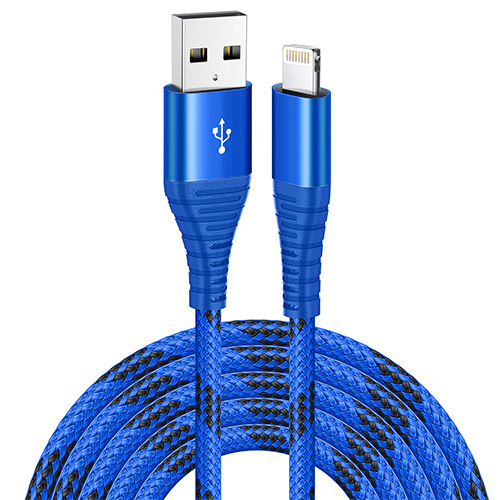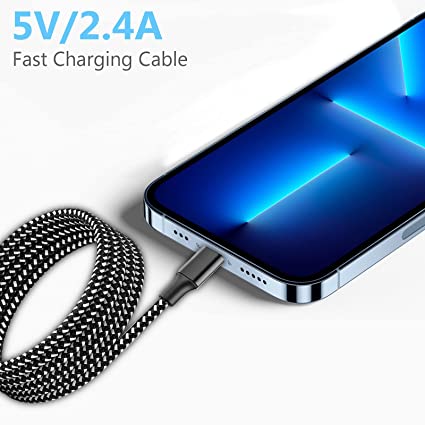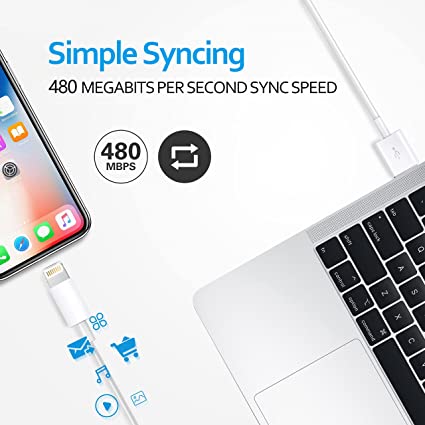A quick read on the latest USB PD 3.1 protocol specifications and features

Have you ever missed important moments because of a drained battery, or felt impatient because of slow charging? In this era of vitality and technological innovation, we all rely on various smart devices, which are important partners in our work, entertainment and life. It’s because of these devices that we need faster and more efficient charging solutions, and that’s what we’re talking about today – the USB Power Delivery 3.1 (PD 3.1) protocol.
What is USB Power Delivery 3.1?
Following PD 3.0, in May 2021, USB-IF released a new technical specification called USB Power Delivery 3.1. Following PD 3.0, in May 2021, USB-IF released a super cool technical specification called USB Power Delivery 3.1. This charging protocol version is a major update that delivers up to 240W of power via a fully functional USB Type-C® cable and connector. Compared with the previous USB PD 3.0 specification, which can only provide up to 100W power at 20V voltage and 5A current, it is simply weak.
Following USB Power Delivery PD 3.1 comes a new hero, USB Type-C 2.1 cable! This cable can easily meet the high power requirements of the PD 3.1 protocol and can transmit up to 240W of power. The old USB-C cable simply cannot give full play to the high-power power transmission of the PD 3.1 protocol.
USB-IF also gave these new cables and 240-watt chargers a cool name, EPR, which stands for Extended Power Range. This means we can look forward to a faster and more powerful charging experience in the future, all thanks to the launch of USB Power Delivery PD 3.1 protocol!
Why is USB PD 3.1 protocol needed?
Many devices now require more power than the 100 watts provided by the older USB PD protocol. While 100 watts is more than enough for a smartphone, the latest gaming laptops, 4K monitors, LED TVs, docking stations, mobile workstations, and more have power requirements that far exceed the 100 watt limit.
Fortunately, there is now EPR (Extended Power Range) with the PD3.1 protocol, which means you can provide charging for those devices that require high power. It can even be used to power electric bicycles, electric gardening tools, and laser printers, which consume more power than a 100-watt power supply can handle. It’s like giving your devices a powerful electrical accelerator, ensuring they keep running efficiently.
Features of USB Power Delivery 3.1.
What innovations does the new USB PD 3.1 specification bring? The following are the most important aspects of the USB Power Delivery 3.1 specification:
- Higher voltage:The most attractive change of PD3.1 is that in addition to the previously defined fixed voltages of 5V, 9V, 15V and 20V, it also increases the power to a new level: 28V (100~140W), 36V ( 140~180W) and 48V (180~240W).
- Adjustable power supply mode:The new adjustable voltage mode can achieve an adjustment range of 5V to 48V according to the actual required power, allowing the powered device to have greater flexibility in requesting voltage and current configuration. This means more types of devices can be charged with a single USB-C power delivery 3.1 charger, reducing the need for multiple chargers and adapters.
- Bidirectional transmission: The power direction will no longer be fixed to allow the product (peripheral or host) to provide power to the outside. For example: you can use your laptop to charge your exhausted mobile phone without a power bank. This is also an important reason why PD 3.1 chooses USB C as a dedicated cable.
- More efficient:The USB PD 3.1 specification indicates that the protocol is committed to delivering accurate wattage. Maximum power is allocated to each port when using a multi-port charger, making charging multiple devices more efficient. Enhance user experience by eliminating the hassle of carrying multiple chargers for various devices.
- Introducing a new cable standard:This time PD 3.1 introduces a new power delivery USB C 2.1 cable standard. These new cables intelligently handle power transfer up to 240 watts, giving you more choice and flexibility.
- Future-oriented:As technology continues to advance, the power requirements of new devices will become more and more complex. USB-PD 3.1 is designed to be future-proof and meet the power needs of next-generation devices. This ensures your USB-PD 3.1 compliant chargers and cables remain relevant and useful for years to come.
- Sustainable development: USB-PD 3.1 contributes to sustainable development by reducing the number of chargers and cables required for different devices. This reduces e-waste and simplifies the charging ecosystem.
USB PD 3.1 EPR communication mode.
The PD 3.1 specification includes the power supply specification previously defined in PD 3.0, adding optional EPR (Extended Power Range) functionality to its original SPR (Standard Power Range). Now, your devices can run on 28V, 36V or even 48V, instead of just being limited to standard voltages.
In EPR mode, there are two main types of power outputs (PDOs):
- Fixed PDO:This type provides a constant voltage output, usually greater than 20 volts. This includes 28V, 36V and 48V specifications.
- AVS (Adjustable Voltage Power Supply) APDO:In EPR mode, the voltage output can be adjusted within a certain range, usually from a minimum of 15 volts to a maximum of 28 volts, 36 volts and 48 volts, depending on the power requirements of the device.
AVS is a bit like the previous PPS (Programmable Power Supply Specification), but with some differences. It allows you to adjust the voltage, but does not support current limiting operation. Additionally, the voltage is adjusted in units of 100 millivolts instead of 20 millivolts, making the voltage more finely adjustable.
EPR_Source_Capabilities
The power supply capability is displayed in “Source_Capabilities,” and the same concept is introduced into the EPR mode. “EPR_Source_Capabilities” has been added to the PD 3.1 Specification to support and display the specifications of EPR (Extended Power Range) power supply products.
As illustrated in the diagram from the PD 3.1 Specification below, the first 7 groups of Data Objects are filled with SPR (Standard Power Range) PDO (Power Delivery Object) content, which must match those in “Source_Capabilities.” If the SPR PDO consists of fewer than 7 groups, then 0 shall be used.
EPR PDO content is entered from Group 8 to Group 13, sequentially from low Fixed PDO voltage to high Fixed PDO voltage, followed by a group of AVS (Adjustable Voltage Supply) APDO (Alternate Power Delivery Object). This design ensures consistency and orderliness, enabling effective management of power supply capabilities when devices operate in EPR mode.
EPR Mode Activation Process
Before activating EPR (Extended Power Range) mode for power supply, both the Source and Sink must establish an Explicit PD (Power Delivery) Contract. During this initial phase, both parties verify their compatibility for EPR mode by examining the Source Capabilities and Request Messages. This step serves as a reference to ensure that both parties can support EPR mode before proceeding.
To activate EPR mode, a communication and verification process is necessary, which follows these steps:
- Sink Initiates EPR Mode Request: The Sink device initiates the EPR mode by sending an EPR_Mode message with the Data Object set to “Enter,” signifying the need for communication in EPR mode. The content of the EPR_Mode message may vary based on its purpose (see Figure 3).
- Source Checks and Acknowledges: The Source device checks and confirms that both parties support EPR mode and that its current state is capable of supplying power in EPR mode. It responds with an EPR_Mode message set to “Enter Acknowledged,” indicating that it can indeed support EPR mode power supply.
- Wire Compatibility Verification:In cases involving wired connections, the Source device must additionally verify that the connected wire can support EPR mode. It sends a Discover ID Request to confirm whether the wire can handle a maximum voltage of 50V and a maximum current of 5A.
- Successful Entry to EPR Mode: If all the above checks are successful, the Source device sends an EPR_Mode message with the Data Object set to “Enter Succeeded” to the Sink. This signifies the successful activation of EPR mode, allowing both devices to proceed to the next step, which is the “PD Negotiation.”
This process ensures that EPR mode is only activated when both the Source and Sink devices are compatible and capable of supporting the extended power range, thus facilitating efficient and reliable power delivery in high-power scenarios.

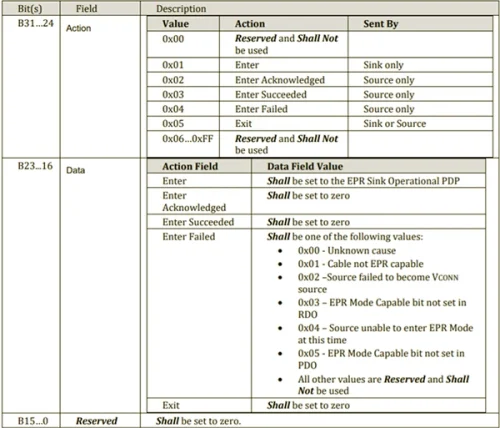
PD Negotiate in EPR Mode
Power Delivery (PD) negotiation in Extended Power Range (EPR) mode involves a series of steps to ensure efficient communication between the power source and the device being charged. Here’s a simplified explanation of how it works:
- Announcing Power Supply Capability: The power source (e.g., charger) sends out a message called “EPR_Source_Capabilities” to inform the device about its ability to provide power in EPR mode.
- Device Selection:The device (e.g., smartphone) selects a suitable Power Data Object (PDO) based on its power requirements. It then fills in an “EPR_Request” and sends this request to the power source.
- Confirmation and Communication:Upon receiving the request, the power source verifies if it can meet the device’s requirements. If it can, it sends back an “Accept” signal. After adjusting its power supply accordingly, it transmits “PS_RDY” to signal the completion of this negotiation.
It is worth noting that the power supply of PD3.1 is much greater than 60W. Therefore, the USB cable must use the E Marker chip during the 3.1 power supply negotiation process to ensure detailed and reliable identification and ensure correct power negotiation. Some PD cables exceeding 100W need to be equipped with E Marker chips on both ends. In EPR mode, the power source keeps an eye on the Configuration Channel (CC) state. If it remains idle for an extended period, the source initiates a “Hard Reset.” This interrupts the EPR mode, so the device (sink) must send periodic “EPR_KeepAlive” messages at specified intervals to maintain the EPR mode. When the source receives these messages, it responds with “GoodCRC” and “EPR_KeepAlive_Ack” to reset the timing.
In essence, EPR mode negotiation ensures that the device and the power source communicate effectively to provide the right amount of power without interruption. For more detailed basic knowledge of USB data transfer mode and information field format, please go to our corresponding blog.
USB PD 3.1 specification table.
| Output support | Voltage/V | Current/A | PDP Rating/W |
|---|---|---|---|
| SPR Fixed PDO | 5; 9; 15; 20; | 3~5; 3~5; 3~5; 5; | 100<X≤140 |
| EPR Fixed PDO | 28; 36; 48; | 4~5; | 140<X≤180 |
| AVS APDO | 15~48; | 5; | 180<X≤240 |
Application of USB Power Delivery 3.1.
USB power delivery 3.1 is a new specification designed to more conveniently charge current devices. This means that all products with new specifications will offer backward compatibility. You will be able to operate at lower power levels with the new 3.1 PD ports. For the same reason: devices with the USB PD3.1 protocol also support charging using USB PD 2.0/3.0 chargers and cables, but the speed is not as fast as expected.
- Wide range of application: The PD 3.1 protocol is suitable for a variety of devices with a power of 240 watts or less, including large monitors, multi-port chargers, workstations, desktops, gaming PCs, large laptops, cameras, and even electric scooters.
- Reduced power block requirements:For some high-power devices, such as printers and hard drives powered by USB, the PD 3.1 protocol will reduce the need for additional power blocks.
- Monitor Powering:The PD 3.1 USB C cable can be used to maintain the operation of monitors that normally require power from a wall outlet.
- Running on a laptop:The USB charger or power bank can run on a laptop equipped with a 3.1 PD USB port.
- High power charging efficiency:Power modules and laptop USB ports with USB PD 3.1 protocol can provide higher power charging efficiency for other electronic devices.
- Faster charging speed: The charging speed of all battery-powered devices will be improved, allowing your devices to be fully charged faster.
All in all, USB Power Delivery 3.1 brings greater convenience and efficiency to charging a variety of high-power-hungry devices while also reducing power adapter clutter. It makes up for the relatively conservative voltage and power transmission characteristics of Qualcomm QC fast charging. This new norm will make our electronic lives more convenient.
PD 3.0 VS PD 3.1
The difference between USB Power Delivery 3.0 (PD 3.0) and USB Power Delivery 3.1 (PD 3.1) mainly lies in the improvement of power transfer capability and voltage range:
- Power transmission capability: The maximum power transmission capability of PD 3.0 is 100 watts. PD 3.1 has been upgraded to 140 watts, 180 watts and 240 watts, which means that PD 3.1 can provide higher power charging and power supply support for more types of devices.
- Voltage range: The PD 3.0 protocol is limited to operating at 20 volts and 5 amps, with a maximum power of 100 watts. PD 3.1 introduces a wider voltage range to suit the needs of different devices, including fixed voltage options of 140W, 180W and 240W.
- New USB Type-C 2.1 cable: In order to support the high-power transmission of PD 3.1, a new USB Type-C 2.1 cable standard is introduced. These cables are capable of handling power transmission up to 240 watts, ensuring transmission efficiency and safety.
In short, PD 3.1 provides higher power transmission capabilities and a wider voltage range than PD 3.0, allowing it to meet the needs of a wider variety of devices and provide faster and more efficient charging and power supply support. This makes PD 3.1 an important protocol to meet the needs of modern high-performance devices.
In summary, USB-PD 3.1 meets the growing power needs of modern devices, enhances compatibility, improves efficiency, and provides a better overall charging experience. It ensures our equipment can meet our evolving technology needs and paves the way for a more efficient and sustainable future in power delivery. Now, it’s time to introduce this powerful technology into your business.
As a professional custom USB cable manufacturer, we understand the importance of USB-PD 3.1 and its critical role in meeting the needs of modern high-performance devices. We lead the industry and have customized production capabilities. Whether you need USB-PD 3.1 charging cables with specific specifications or other USB-related products, we can provide you with high-quality, customized solutions.
No more worrying about slow charging or a charger that doesn’t match your device. Work with us to make your product charging experience faster and more convenient. Contact us now to establish communication. We will provide you with customized USB-PD 3.1 solutions to meet your needs! This is an era of recharge and change, let us create the future together!
Does USB-PD require a specific cable?
USB-PD requires communication via CC pins, which are present in the USB C connector but not in the USB A connector. The A to C cable provides a fixed current on the CC pin (via a pull-up resistor internal to the Type-C port) to indicate the maximum current supply capability of the A side. At the same time, when the voltage is too high, the cable port needs to be equipped with a voltage adaptive detection chip to better protect the device battery.
Do all phones support USB-PD?
After 2022, almost all new smartphones, tablets, laptops or wearable devices will support the use of the USB PD protocol. But if you have an older model of phone you’ll want to check the device or factory manual for the best tips.
Does USB PD harm the battery?
The great thing about USB PD is that it communicates between the charger, cable, and device to coordinate the maximum power the device needs. The phone only consumes the power it needs to optimize charging and do so safely. But it is still recommended that you do not overcharge.
Is PD 3.1 the highest limit for USB Power Delivery?
USB PD3.1 represents the current pinnacle of Power Delivery fast charging technology, but it will not always be so. Along with the advancement of electronic technology, charging technology will also grow together. In the future you will see higher power and smarter mobile electronic technologies.

Fast delivery
Fastest delivery within 22 days

Quick proofing
Fastest 3-day proofing cycle

After-sale protection
24-month long warranty

1V1Customer Service
Professional customer service follow-up

